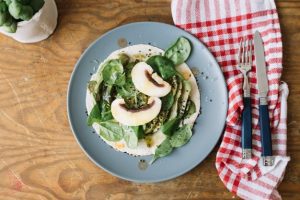Are you trying to lose weight? On the lookout for an all-new diet that could get the job done but don’t know which one? Have no fear because in this article we’re going to explain all the basics of the keto diet.
What is the Keto Diet?
The keto diet goes by a few different names: such as the ketogenic diet or even the LCHP diet (low carbs, high protein). This diet is an extremely effective means of losing weight. Mostly because carbohydrates are real good at making you pack on the pounds.
This is because carbs, including refined starches or fiber, convert into sugar once digested. So yes, this includes cutting out soda and even fruit juices.
The objective of the keto diet is to enter a new metabolic state called ketosis! After eating fewer carbs and high amounts of protein, your body takes energy from your body. You find this energy in fat instead of the sugars stored in carbs.
Entering ketosis makes it super easy to lose weight. It also has its own benefits such as increased cognition, mood and awareness!

Nutritional Intake for the Ketogenic Diet
You may already be thinking, what exactly do I eat on the keto diet? Fortunately, the answer isn’t overly complicated.
Following the keto diet, you want to match an exact amount of nutrients each day. 70% should come from fat, 25% should come from protein and 5% should come from carbohydrates.
So, why do you need so much fat? Because fat is the most important part of the keto diet. As explained earlier, this is how you’ll enter ketosis and start using fat as your internal source of energy.
Fats contain twice as much energy and calories as proteins or carbs. Triggering ketosis takes advantage of this process so that your metabolism has extra energy to work with.

The reason a quarter of your nutrients should be protein is because it too is an important energy source! As you already know, protein is great for building mass during exercise. Protein is also great for getting a more complete nutritional intake.
To maintain your muscle mass, you need to focus on getting enough protein while on the keto diet. Fat alone won’t be enough for you to maintain mass.
The 5% carb intake is also there to increase the intake of essential nutrients. Here are a few ways you can get just the right amount of both. In fact, many important groups of fruits and vegetables have carbs. Any healthy diet should consider the vitamins and minerals inside these foods!

Meals for the Keto Diet
You must be wondering what exactly you can eat on this diet? Hopefully, the answer will please you. While entering or within ketosis, there are specific foods you should eat:
- Eggs
- Dairy (including full-fat cheese, butter and yogurt)
- Fatty fish such as salmon
- Avocados
- Low-carb vegetables (leafy greens, tomatoes, mushrooms, peppers)
- Poultry and meat
- Nuts and seeds
You can find these foods at FreshDirect for good quality and cheap prices!
Foods that you will always want to avoid include:
- Baked goods and bread
- Any sweet or sugary junk food including soda beverages
- Legumes
- Any high fructose fruit
- High carb vegetables (including potatoes and corn) a
- Pasta

Here are some specific examples of what you might eat in a day.
For breakfast, you could have a mushroom omelet. Eggs are important because they’re so nutritious and are a great source of protein, and mushrooms are a low-carb veggie.
For lunch, consider having a tuna salad with various vegetables like tomatoes or celery. Seafood will give you good amounts of protein and fatty acids. Plus green vegetables can give you some of your carbs and a lot of vitamins.
Finding keto-friendly snacks shouldn’t take hours wandering around, staring at the back of labels at grocery stores. Try out a keto snack box from Cratejoy!
For dinner, try something meaty, like pork chops or steak mixed in with some veggies and a lot of butter or buttery sauce.
There you have it. The keto diet is strict, but has proven to be effective. And if you’re trying to tone up, this is one of the best ways to finally get that six-pack you used to have in college back.
Your body will burn off your belly fat and stop relying on carbs for its energy all the time. It may take a while to see results though, so stick to it and if you’re doing it right, it won’t let you down.






